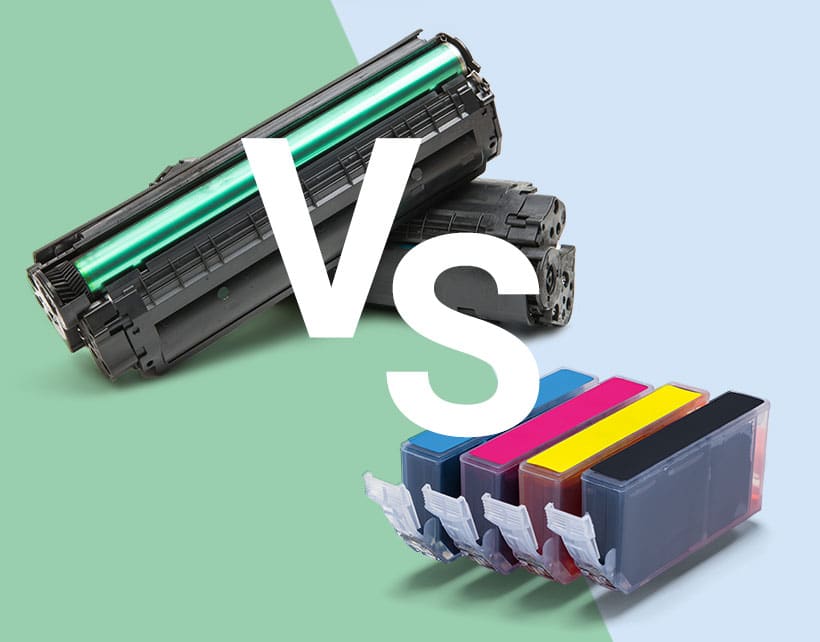
Ink and Toner: Your Ultimate Buying Guide
If you’re trying to resolve the debate of ink vs toner printers and cartridges for your needs,
check out this comprehensive guide.
What is printer toner and how is
it different to printer ink?
Each day offices around the world print reams of documents and other paperwork. Having a good printer and plenty of paper is important, but none of this can work without ink or toner. Printer cartridges are an essential part of any well-functioning office, so it’s important to choose the right ones to meet your needs. Our guide to the types of printer ink should help you make the right choice.
What is a printer toner cartridge?
A printer toner cartridge is designed to fit in a laser printer. The cartridge contains toner powder, which is used to create text and graphics on a page through a heated printing process. This toner powder is made from ground polyester which can hold a static charge and connect to anything with the opposite charge; this is how the laser printing process works.
Toner cartridges only have a finite life and must be replaced periodically once they’ve run out of toner. One common complaint about laser printers and the toner cartridges required to use them is cost. Printer toner cartridges are known to be generally more expensive than other options, but can offer a higher yield of pages per cartridge.
What is an ink cartridge?
An ink cartridge is designed to work with an inkjet printer. These types of printers are more common than laser printers and can prove to be less expensive, both for the actual printer and the cartridges. Inkjet comes in two different types of ink— dye-based and pigment based. Dye-based inks are colourants dissolved in liquid, whereas pigmented inks use fine powder suspended within liquid.
Inkjet cartridges usually come in four different colours— cyan, magenta, yellow, and black. Each of these can be replaced separately; for instance, if you use black more often to print of large volumes of text, you may find yourself replacing this more often.
What does toner do in a printer?
The printing process in a laser printer is very different to that of an inkjet printer.
There are numerous processes that take place within the printer in order to create your document.
A laser creates an electrostatic template of your desired printing on a rotating metal drum.
This drum also has an electrical charge.
The printer cartridge dispenses toner onto the drum; this toner only sticks to certain parts
of the drum where the laser has altered the electrical charge.
The printer also adds an electrical charge to each piece of paper as it comes through the machine and,
as the sheet comes past the drum, it pulls off the charged toner to make up the desired printing pattern.
Finally, a hot fuser melts the polyester powder into place, leaving the finished printing behind.
Which printer has the cheapest ink?
Picking the right type of printer with the right type of printer cartridges depends entirely on your own personal needs and how much you intend to use the device. Inkjet printers are generally much cheaper to purchase upfront, however they can be more expensive to operate and you’ll need to replace the ink cartridges more frequently. For someone who doesn’t print very often, an inkjet printer could be a good option.
When it comes to cost-per-page, laser printers are much cheaper than inkjet. Laser printers make a better option for busy offices, where numerous people are frequently printing off black and white documents. On top of that, laser printers tend to be much larger than inkjet printers, meaning they’re better suited to an office setting.
Should I buy compatible ink cartridges?
The debate between using original cartridges or compatible printer cartridges is a common one, with compatibles often available for much cheaper than those provided by the manufacturer. But is it a good idea to use them?
Original ink cartridges, sometimes known as genuine, are made by the manufacturer of the printer and are designed specifically for that device. A genuine cartridge can be identified by the letters OEM (Original Equipment Manufacturer) printed on them. Many people believe that original cartridges offer better quality printing as printer manufacturers tend to use oil-based inks. It is also believed that they are safer to use and pose less risk to your printer. It’s true that original ink cartridges are designed specifically for that printer. However, compatible ink cartridges also offer a high-quality, safe alternative to genuine cartridges if you don’t want to stretch your budget too far.
Compatible ink cartridges, crafted by third-party manufacturers, present a viable substitute to genuine cartridges. These alternatives, often available through reputable high street or online retailers, are engineered to seamlessly integrate with your printer. While compatible cartridges typically offer greater ink capacity than their genuine counterparts, there’s a common misconception about their ink quality. Contrary to popular belief, the ink utilised in compatible cartridges isn’t inherently inferior; rather, it’s predominantly water-based, which may result in a slight variation in output compared to originals.
It’s essential to dispel the notion that compatible cartridges are inherently detrimental to your printer’s warranty. While some printer manufacturers may stipulate the use of genuine cartridges to maintain warranty coverage, this doesn’t discredit the reliability or value of compatible alternatives. In fact, for budget-conscious consumers seeking cost-effective printing solutions without compromising quality, compatible cartridges emerge as a practical and economical choice. By embracing compatible cartridges, you not only expand your options, but also enjoy significant savings without sacrificing performance. Choosing the right printer cartridges might seem like a relatively trivial decision, however it could have a big effect on the quality of your printing and overall costs. Whatever type of printer you own, or are considering, make sure you have the best possible toner and ink cartridges.
Admin Notice: No Viking Direct products found in this post.
Admin Notice: No Viking Direct products found in this post.
Admin Notice: No Viking Direct products found in this post.






